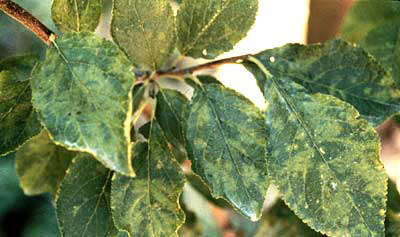Cornell plant scientists detect presence of plum pox virus -- disease of all stone fruits -- for first time in New York state
By Franklin Crawford


Cornell plant scientists, working with state and federal officials, have detected the first cases of plum pox virus (PPV) in New York state on trees from orchards in Niagara County. The discovery was made by the Cornell University Plant Disease Diagnostic Clinic early in July and confirmed by the U.S. Department of Agriculture (USDA). Plum pox is a viral disease of stone fruits, including plums, peaches, apricots and nectarines.
"Specialists are currently surveying a five-mile radius surrounding the initial detection to determine the extent of infestation," said Jessica A. Chittenden, communications director for the New York State Department of Agriculture and Markets (NYSDAM). "The USDA will establish a cooperative eradication program with the state of New York."
The disease, spread by insects, is not harmful to humans. The PPV strain identified in New York is identical to the D strain of the virus found in both Canada and Pennsylvania, according to the USDA. The D strain is less virulent than other strains, making it easier to contain. New York is only the second U.S. state where plum pox has been detected.
Cornell scientists identified the virus while performing laboratory tests for NYSDAM's national seven-year survey for the virus. The Cornell Plant Disease Diagnostic Clinic works closely with state officials and the USDA National Plant Germplasm and Biotechnology Laboratory in Beltsville, Md., providing testing services and identifying newly-introduced pathogens as they arrive.
"Members of the Cornell laboratory have been, and continue to be, trained to perform state-of-the-art plant pathogen identification techniques," said Karen L. Snover-Clift, director of Cornell's Plant Disease Diagnostic Clinic. "Because of this readiness commitment, laboratory personnel were prepared to perform the initial testing, to recognize the suspect results and to perform additional testing needed to confirm the presence of PPV in the sample submitted as part of the national survey."
PPV, also known as Sharka, has been devastating stone fruit crops in Europe since the early 1900s, when it was first reported in Bulgaria, then spread throughout Europe. In recent years the disease has spread to the Americas, first being found in Chile in 1992, in the orchards of Adams County, Pa., in 1999, and in Ontario and Nova Scotia, Canada, in 2000. The disease remains localized at this time and state and federal officials continue efforts to contain and eradicate PPV before it has a chance to spread to other parts of the North American continent.
For more information, contact Snover-Clift, director of Cornell's Plant Disease Diagnostic Clinic, (607) 255-7860, kls13@cornell.edu.
Get Cornell news delivered right to your inbox.
Subscribe